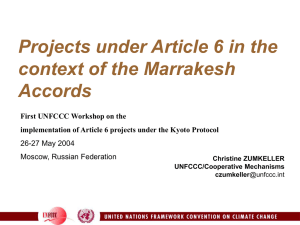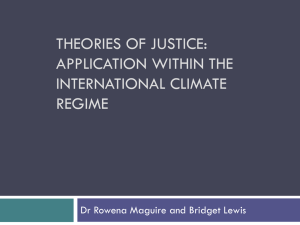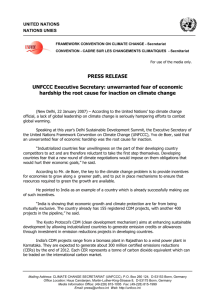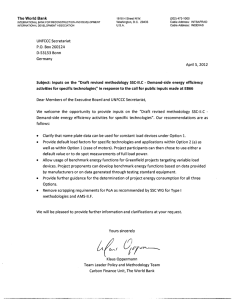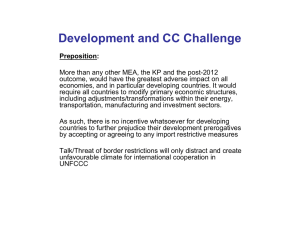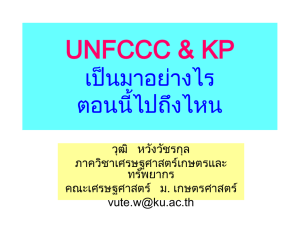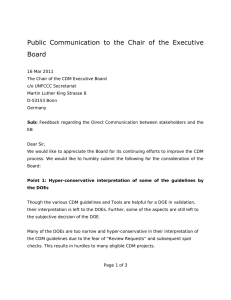T UNFCCC O
advertisement
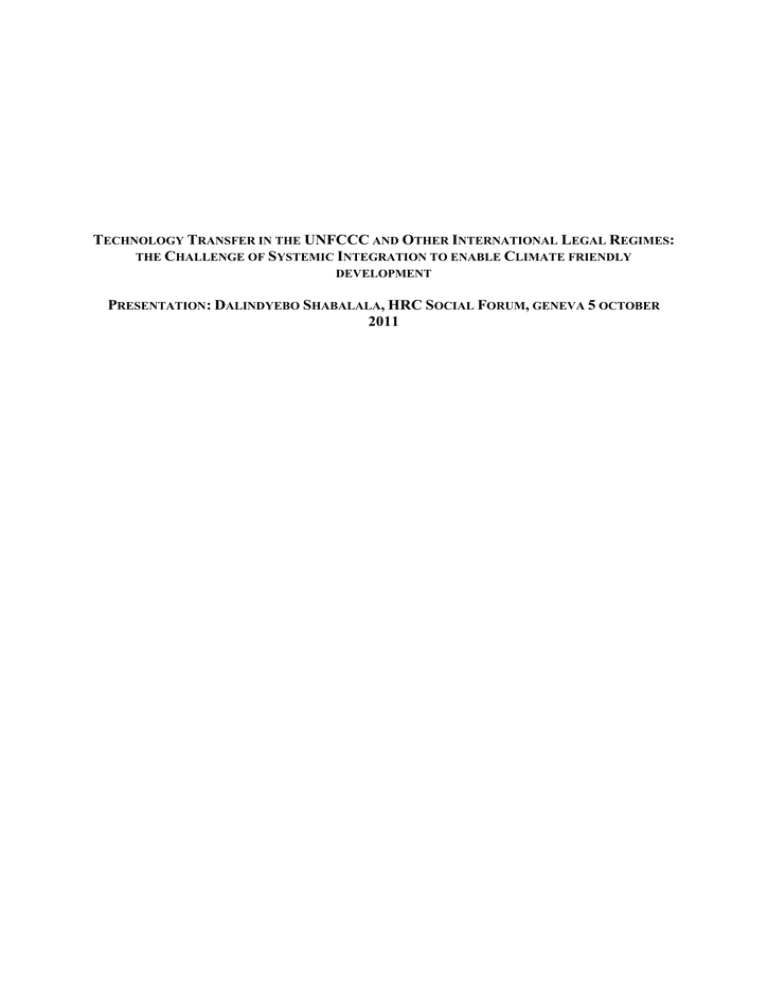
TECHNOLOGY TRANSFER IN THE UNFCCC AND OTHER INTERNATIONAL LEGAL REGIMES: THE CHALLENGE OF SYSTEMIC INTEGRATION TO ENABLE CLIMATE FRIENDLY DEVELOPMENT PRESENTATION: DALINDYEBO SHABALALA, HRC SOCIAL FORUM, GENEVA 5 OCTOBER 2011 I. Introduction The United Nations Framework Convention on Climate Change (UNFCCC) and its Kyoto Protocol were built on a fundamental political and legal bargain directly involving technology transfer. On one side industrialized countries would take the first steps to reduce GHG emissions. They would move toward low-carbon or carbon-free economies, while transferring technology to enable developing countries to make progress on carbon efficiency. Thus, carbon leakage, i.e., the shifting of polluting carbon-inefficient industries from industrialized to developing countries, would be avoided. In addition, developed countries would provide financial and technical assistance to developing countries to build capacities to adapt to the negative impacts of climate change. Developing countries have argued that commitments on technology development and transfer have not been met and that the necessary conditions that would enable them to take action on GHG emissions reductions have not been met. Specifically, developing countries have argued that industrialized countries have largely failed to provide effective transfer of environmentally sound, climate-related technologies. Analyses vary as to the causes for the perceived failure of industrialized countries to deliver on technology transfer. Many industrialized country governments argue that they have actually delivered on their technology transfer commitments and that the problem lies in enabling environments and absorptive capacity in developing countries. Factors that contribute to this perceived impasse include: the absence of political will; lack of agreement on definitions and methodologies for what constitutes technology transfer; the lack of institutional capacity in both developing and industrialized countries to enable, measure and verify technology transfer. ICHRP and CIEL have argued that a key element is the low profile of powerful ethical, rights-based arguments regarding international obligations to transfer technology, even as these underpin the arguments regarding the negative effects that climate change will have on development, and the fundamental damage to development posed by demands by industrialized countries that developing countries must take on GHG mitigation commitments, in the absence of equally strong and enforceable commitments to deliver on financing and technology transfer. One area where all these arguments come together are disagreements about the role of intellectual property (IP) as a barrier to developing and disseminating climate related technologies in developing countries. In a nutshell, developing countries have argued that restrictive and high intellectual property standards in international treaties, especially TRIPS, constrain their ability to access products and knowledge, to enable them to address climate change and develop. In particular, the debate on IP and Climate change revolves around two issues: the barrier that IP poses for developed countries to enable technology transfer; the barriers that IP poses for developing countries to exercise unilateral options where developed countries have failed to deliver on technology transfer and financing. The regimes in which IP norm-setting has historically being done, the World Intellectual Property Organization (WIPO) and the World Trade Organization (WTO) have been viewed as unwilling to include concerns regarding to the needs and concerns of technology transfer to address climate change. 2 The history of the Right to development has been one of sequencing, prioritization and arguments about conflicts of rights and conflicts with other systems of international economic and environmental governance. Given this scenario of potentially competing norms arising out of variegated areas of international law, the potential for conflicts and tensions may undermine effective policies ensuring the transfer of climate change-related technologies. II. What role does the UNFCCC legal regime play? Technology transfer in the UNFCCC is governed by some of the clearest and strongest international legal obligation in environmental and economic governance and some of the clearest articulations of the primacy of development as the over-riding priority for developing countries. Technology transfer is addressed in Article 4 of the UNFCCC. This provision covers a range of issues, including financing, transfer and commitments. Notably, Article 4.7 links the ability of developing country Parties to fulfill their commitments under the UNFCCC to the effective implementation of developed country Parties fulfilling their commitments, particularly financial and technology transfer. Further, while the convention provides for the diffusion of technologies amongst all Parties, the key provision for transfer of technology from Annex II to developing countries is Article 4.5: The developed country Parties and other developed Parties included in Annex II shall take all practicable steps to promote, facilitate and finance, as appropriate, the transfer of, or access to, environmentally sound technologies and know-how to other Parties, particularly developing country Parties, to enable them to implement the provisions of the Convention. In this process, the developed country Parties shall support the development and enhancement of endogenous capacities and technologies of developing country Parties. Other Parties and organizations in a position to do so may also assist in facilitating the transfer of such technologies. Clearly the right to development is implicated by the UNFCCC legal obligations and should be the basis on which arguments regarding burden-sharing and technology transfer for mitigation and adaptation should be made. In this sense, the UNFCCC is an example of the successful integration of the rght to development in the insititutional framework of climate change. One way to view a rights-based approach is that there would be a basis for making a direct demand for access to technology from those who are holders of technology. Such a demand would be based on a direct right to access technology or on access to technology as a necessary component for the fulfillment of other rights. The other view of a rights-based approach is that, in the exercise of policy choices such as the determination of beneficiaries, the prioritization of resources, the evaluation of success or failure, the primary criteria for doing so should be the extent to which human rights standards are met and fulfilled. Problems for Applying a rights-based approach to technology transfer for climate change 3 a. The Role of Transnational Corporations and other Private Actors Such corporations are the primary owners of intellectual property and technologies both as a function of industrial head start but also deliberate industrial policy to transfer IP into the hands of these corporations by developed countries. In the ongoing discussions there may not yet be sufficient basis yet for directly addressing transnational corporations. b. The Duty to Provide International Assistance and Cooperation ICESCR Article 2 requires each State Party “to take steps, individually and through international assistance and co-operation, especially economic and technical, to the maximum of its available resources, with a view to achieving progressively the full realization of the rights recognized in the present Covenant by all appropriate means...” ICESCR Article 23 elaborates on this requirement, stating that international action includes “the conclusion of conventions, the adoption of recommendations, the furnishing of technical assistance,” and other methods. The CESCR has repeatedly drawn attention to the essential role of international cooperation in achieving the full realization of particular rights under the ICESCR, stating that State Parties should “comply with their commitment to take joint and separate action” to achieve this goal.1 These issues in addition to state obligations under the WTO, WIPO and in Investment treaties restrict the ability of developing countries to take unilateral action, and are used as justification for not addressing IP issues in the UNFCCC legal framework. How then to address conflicts that may limit: - unilateral options for developing countries to address technology transfer and fulfil these rights - multilateral approaches to burden-sharing and implementation of UNFCCC obligations on technology transfer? One approach is that the Right to development on its own may provide a basis but only insofar as it can be invoked on those situations where there is a) a conflict between norms that may limit unilateral action by a developing country b) a failure of states to meet their international obligations V. Systemic Integration as a solution to norm conflict and a tool for more tightly integrating the right to development into the climate change regime The Legal Relationship between the UNFCCC and Other Regimes. The UNFCCC treaty itself mentions how it should relate to other regimes. The preamble affirms “that responses to climate change should be coordinated with social and economic development in an integrated manner with a view to avoiding adverse impacts on the latter, 1 Id. 4 taking into full account the legitimate priority needs of developing countries for the achievement of sustained economic growth and the eradication of poverty.” Then UNFCCC Article 4.1(f) commits Parties to: Take climate change considerations into account, to the extent feasible, in their relevant social, economic and environmental policies and actions, and employ appropriate methods, for example impact assessments, formulated and determined nationally, with a view to minimizing adverse effects on the economy, on public health and on the quality of the environment, of projects or measures undertaken by them to mitigate or adapt to climate change. Further, Article 3.5, on principles, notes: The Parties should cooperate to promote a supportive and open international economic system that would lead to sustainable economic growth and development in all Parties, particularly developing country Parties, thus enabling them better to address the problems of climate change. Measures taken to combat climate change, including unilateral ones, should not constitute a means of arbitrary or unjustifiable discrimination or a disguised restriction on international trade. The relationship of the UNFCCC to IP regimes has become a significant part of the debate within the UNFCCC. Under the theme of “Enabling Environments for Technology Transfer,” the Parties at the 13th Conference of the Parties in Bali recommended that all Parties “avoid trade and intellectual property rights policies, or lack thereof, restricting transfer of technology.”2 However, common ground on the interpretation of this recommendation and more generally on the question of whether IP constitutes a barrier to technology transfer does not appear to be forthcoming. Within this discussion there have been suggestions from countries, such as Bolivia, that addressing climate change and enabling technology transfer requires fundamental changes to the existing architecture of international IP law, particularly the TRIPS Agreement. VI. International Law on Human Rights and Technology Transfer Traditionally, human rights obligations function in international law as obligations erga omnes and thus, by definition, are applicable law for all States in all their activities. Moreover, human rights are fundamental and cannot be contracted out of. In addition, certain human rights are recognized as jus cogens, thus having formal primacy over other international norms. Outside of jus cogens, human rights norms have more force than other norms given that they provide the moral foundation for the international community and thus concern fundamental values of the international community. 2 UN Framework Convention on Climate Change, ‘Recommendations for enhancing the implementation of the framework for meaningful and effective action to enhance the implementation of Article 4, paragraph 5, of the Convention’, in Development and transfer of technologies under the Subsidiary Body for Scientific and Technological Advice, (14 March 2008) U.N. Doc FCCC/CP/2007/6/Add.1 <http://unfccc.int/documentation/decisions/items/3597.php?such=j&volltext=/CP.13#beg> (accessed 8 June 2010) 5 To the extent that the issue of how to relate to other regimes has been taken up, the human rights committees have consistently applied the standard that human rights are fundamental obligations of states which are not subject to ‘balancing’ tests. They can be mutually supportive with other regimes but only to the extent that such regimes remain compatible with human rights law. VII. SYSTEMIC INTEGRATION The ILC puts forward a principle it calls “systemic integration,” rooted in the application of VCLT Article 31(3)(c), to address the potential conflicts that arise as a result of the diversification and expansion of international law. The principle is premised on the insight that at the core of all the legal approaches and techniques to address conflicts is the idea of relationships within a broader system. The ILC suggests that all interpretive decisions should take place against that broader systemic background with full awareness of the links, accompanied by a proactive attempt to integrate different rules with each other and that broader systemic background which consists of general international law, jus cogens obligations, and obligations erga omnes.3 Thus, care must be exercised not to invalidate other provisions in other treaties and regimes. Interpretation should render both provisions operational and compatible, and if that is not possible, the rule that is determined to have priority must nevertheless take the other rule into account. The first form of application of the principle of systemic integration requires the determination of a methodology that can identify which regimes and treaties merit integration. Regimes and treaties that merit integration will depend on whether a treaty deals with the same or related subject matter. In this connection, a “basic effects” test could be employed, involving an examination of whether or not one set of provisions in a treaty would essentially limit, negate or impair the effectiveness of other provisions or regimes. However, when looking at applying the basic effects test, i.e., on the realization and/or effectiveness of the provisions in another treaty or regime, the first place to look for guidance is to treaties that share objectives. Once shared objectives are established, a connection can be clarified by seeking specific shared provisions that suggest that the provisions need to be read together in some fashion to give effect to all of them. A second form of application of the systemic integration principle may be applied by looking at the competencies of particular treaty regimes and their obligations to address particular issues. Competency is a subject matter question which overlaps with jurisdiction to a certain extent. Though competency will be rooted in the constitutive instrument of the treaty or forum, and a second effects test that will require a fora examination of the areas of law that may determine the effectiveness of the regime and integrate those bodies of law as applicable law within the fora. The aforementioned approach has been adopted by the WTO Panels and the Appellate Body. 3 Martti Koskenniemi and others, ‘Fragmentation of International Law: Difficulties arising from the Diversification and Expansion of International Law: Report of the Study Group of the International Law Commission’ (13 April 2006) para 410-415, UN Doc. A/CN.4/L.682; ILC, ‘Fragmentation of International Law: Difficulties Arising From the Diversification and Expansion of International Law, Report of the Study Group of the International Law Commission’ (18 July 2006) UN Doc. A/CN.4/L.702 6 VIII. Implications for UNFCCC Policies and Norm-setting Systemic integration will allow and enable unilateral action in pursuit of these objectives and provide a defense if there is a complaint laid in international for a such as WIPO or the WTO. To achieve these goals, the UNFCCC will have to provide direction and guidance to national policy makers and to decision-makers in other fora to cooperate, adapt, and integrate these objectives into their norm-setting and work programmes. Avoidance of conflicts Going forward, a key step to enable the UNFCCC to address technology transfer will be to rely on proactively avoiding recognized conflict conditions. Proactive conflict avoidance accentuates non-norm setting solutions like joint cross-border research and development (R&D) that will ensure that all involved parties have ownership. The establishment of global voluntary patent pools is another avoidance strategy. Global voluntary patent pools consist of rightsholders placing technologies in exchange pools where rightholders are able to access others technologies, the know-how, and the capacity building to make the most effective use these other technologies. To further avoid conflict, parties could place technologies and know-how in the public domain to make them readily accessible. Proactive Options The importance of a clear and consciously chosen strategy for interacting with other regimes cannot be overstated with respect to the climate change regime. Given the broad range of areas affected by climate change, conflicts regarding both objectives and methodologies are inevitable. First, the new UNFCCC Agreement, or the COP decisions relating to any such Agreement(s), must elaborate general interaction and savings clauses that account for the broad shared objectives and the specific shared provisions among the UNFCCC and other regimes. These “interaction clauses” will enable the agreement to more comprehensively address the relationship to other regimes, and put forward a pro-active mode of cooperation rather than one of avoidance.4 In the specific case of technology transfer, an option may be the use of an International Declaration on Climate Change and Intellectual Property Rights (DCCIPR). Similar to the Doha Declaration on Public Health, DCCIPR will be an interpretive statement of existing international law on the issue, while also providing a decision framework for organizations that encounter the issue. While the Doha Declaration is largely limited to discussion on compulsory licenses, the DCCIPR may need to be broader. The proposed declaration should address the full panoply of flexibility and policy options available to member states under the international intellectual property regimes. There are, nevertheless, some areas of existing international economic law, especially within the TRIPS Agreement and under treaties administered by WIPO, which might need to be addressed specifically. The UNFCCC can specifically address this purpose by either making an agreement on these issues that notes that it is acting as lex specialis (a special application 4 Harro Van Asselt and others, ‘Global Climate Change and the Fragmentation of International Law’ (2008) 30 Law and Policy 423, 431 7 of the general law), or to request that the other organizations proceed to make the adjustments. Comity would make the second option more attractive, but in terms of ensuring that the effectiveness of the UNFCCC takes priority, it may be best to carry out such standard setting within the UNFCCC. The specific policy directives that the UNFCCC could pursue include: - - Reinstating the non-actionability of R&D subsidies in the WTO, only for developing countries, for the purpose of enabling developing countries to provide subsidies for environmentally sustainable climate technologies.5 Non-actionability could also be made available for those developed country subsidies that included and enabled participation of developing country projects. Expanding the approach of TRIPS Article 66.2 in order to include all developing countries, and not just least-developed countries, especially those without a strong scientific or technological base.6 These examples illustrate the possibility of an agreement to be reached under the UNFCCC, without creating actual conflict(s) in international law. The aforementioned examples would not require amendment to the TRIPS Agreement or to treaties administered by WIPO. While there may be some argument regarding minimum levels of protection, an agreement in the UNFCCC could also state that such action are per se covered by either general exceptions in IP law, or are considered to be acceptable exceptions and limitations under Article 30. These would function as subsequent agreements under article 31(3)(b) of the VCLT. 5 Bernard Hoekman and others, ‘Transfer of Technology to Developing Countries: Unilateral and Multilateral Policy Options’ (1 June 2004) World Bank Policy Research Working Paper No. 3332, 25 <http://ssrn.com/abstract=610377> accessed 8 June 2010 6 Ibid 8
